10 Best Golf Tips for Senior Golfers in 2024
10 Best Golf Tips for Senior Golfers in 2024
Like most things in life, golf only gets harder as we get older. We may still feel twenty-five at heart, but the physical realities of age are there.
We lose flexibility. Less flexibility means a decrease in our range of motion. A lower range of motion means a shorter golf swing.
And a shorter swing means less distance and power in our golf shots.
Don’t worry. None of this means your game is on a permanent backslide. With a few tricks, you can still play great golf well into your 60s, 70s, and even 80s.
I’m going to share my best golf, including driver tips for senior golfers, and advice for increasing your range of motion. I’ll also share senior-friendly warm-up techniques, suggestions for instruction and equipment, and a whole lot more.
Before you know it, you’ll finally get back some of the distance you may have lost.
It’s easier than you think.
Quick Answer: The Best Tips for Senior Golfers
To learn these tips in greater depth, keep reading below. For now, here’s the short version:
- Find equipment designed for senior golfers.
- Master the senior golfer’s grip.
- Fix your golf posture.
- Flare your toes for more stability.
- Keep your upper body relaxed.
- Let your hips turn.
- Build swing speed by shifting pressure between your feet.
- Add loft on the tee.
- Stop extending your arms on chip shots.
- Embrace a new tee box if it’s going to help your game.
- Learn senior-friendly stretches.
- Adapt your swing technique to suit your strengths.
- Find instruction tailored for senior golfers.
Tips For Beginner Senior Golfers
Here are my 3 best golf tips for older golfers:
— USGolfTV (@usgolftv) June 20, 2024
1. Swing the club more with your arms. Body rotation swings are great when we have the flexibility and strength of youth but as we age this becomes more challenging. Copy many of the all time greats and use your arms more in your…
Golf can be a challenging sport to start playing at any age in life. But the best part of the game is we can play it for our entire life. For seniors who are looking to learn the game of golf, there are a few quick tips that will make golf more enjoyable right away!
1. Choose Senior-Friendly Golf Equipment
Understanding the proper equipment for seniors to purchase is vital to the enjoyment of the game. If you are new to the sport, you have probably noticed there are a lot of different golf clubs, shafts, golf balls, and other types of equipment.
There are two main factors to consider when buying a set of clubs. These two factors are head design and shaft stiffness.
What Head Design is Best for an Iron?
Head design is the make of the iron. There are a few different types of iron: blades, cavity backs, and forged irons.
- Blades are skinny iron heads that are difficult to hit consistently. These irons are meant for the advanced golfer who generates a lot of club head speed.
- Cavity backs are an in-between club for advanced players who are looking for a bit more forgiveness than a blade.
- Forged irons are the most popular choice among golfers. Forged irons offer the most forgiveness and distance. They are a prime candidate for your average golfer.
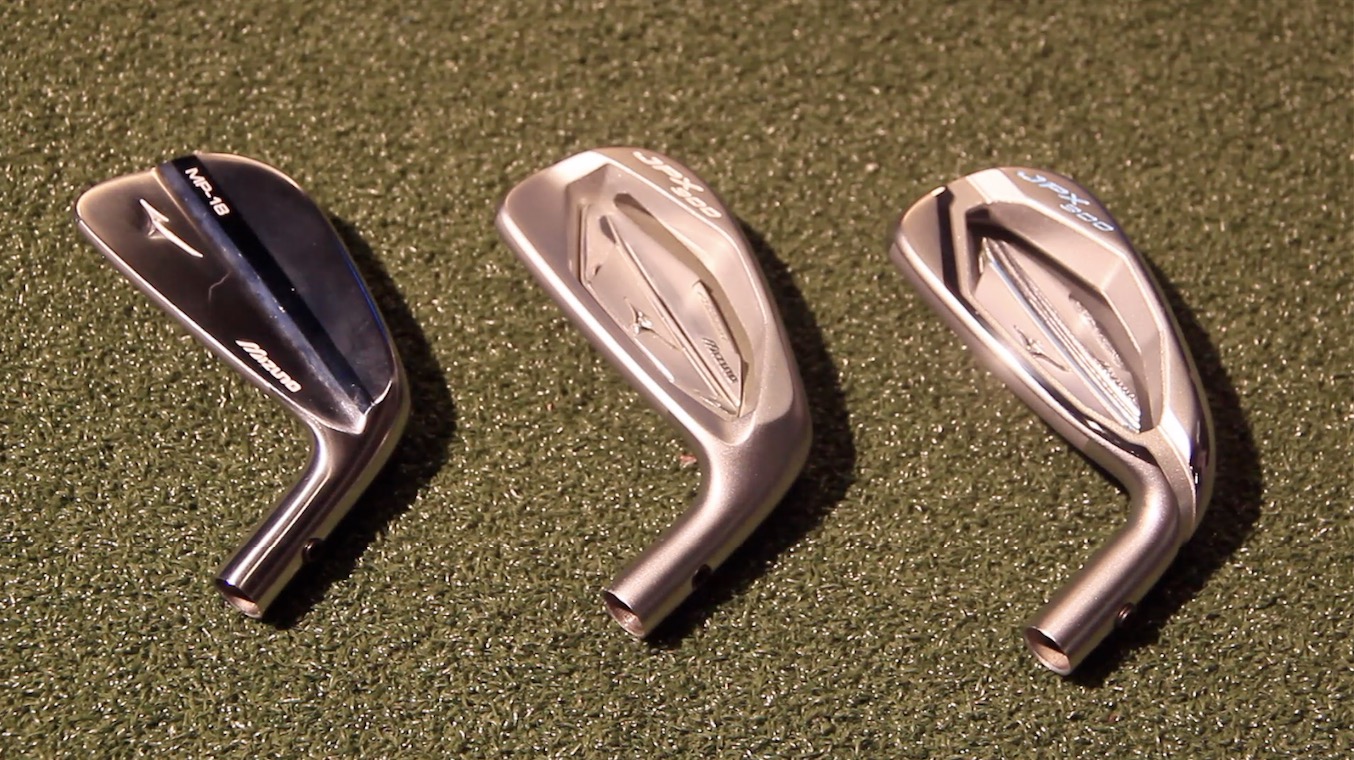
Within the forged irons there is a little bit of variety. The size of the sole of the head is important. The skinnier the sole of the club, the harder they will be to hit.
For beginner senior golfers I would recommend purchasing a forged iron with a wider sole. This will give you the most forgiveness and distance with your irons.
What Head Design is Best for a Driver?
As for the driver, make sure the driver has a lot of loft. Most amateur golfers have driver heads with too little loft. Look for drivers that have 10.5-12.5 degrees of loft.
But head design is not all that we need to know.
What is the Best Shaft Stiffness for a Senior Golfer?
Shaft stiffness is an important feature in golf clubs. Having the proper shaft in your clubs will allow you to make good swings and not feel like you need to swing too hard.
For seniors, there is what is called senior flex shafts. This is the best option for a beginner senior golfer. If the shaft is too stiff, you will not be able to generate enough clubhead speed for the shaft to work properly.
What are the Best Clubs for Senior Golfers?
One of the biggest challenges senior golfers face is the frustrating fact that golf equipment isn’t really made for them. Major manufacturers engineer clubs to get the best possible performance from professional golfers.
If you don’t have a professional golfer’s strength, precision, and range of motion, you’re not going to get the same results with a club designed for them.
That’s why I recommend three clubs that were engineered with senior golfers in mind with two VLS:
- VLS Maxvert 1 Driver – Most golfers pick up 10-30 yards and hit it much straighter off the tee within their first few swings with this driver. They don’t even have to change their technique.
- VLS Maxvet 1 Hybrid – Don’t give up on hybrids yet, especially if you want to hit the ball better. You’ll get better contact, launch, and distance with this one than you will with the one that’s currently in your bag. It’ll save your life on a wide range of shots off the tee and down the fairway.
- G-Track Putter – This is the first and only fully adjustable putter. You can modify your shaft position and setup to overcome several senior-specific challenges, including aim, involuntary twitches, and lower back pain.
2. Learn a Senior-Friendly Grip
First and foremost, the grip and setup are extremely important for beginner senior golfers to understand. The correct setup will allow for the most rotation possible in our backswing and follow-through.
Let’s talk a little bit about grip. For beginning senior golfers, I recommend following these steps:
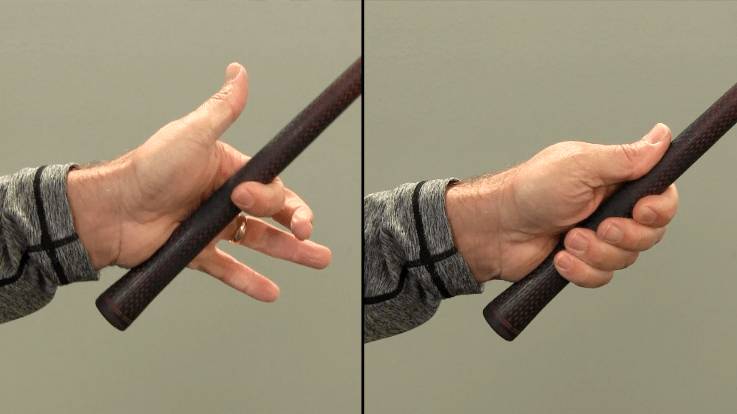
- Put your left hand on the grip. Make sure the grip is more towards the fingers versus the palm. This allows you to have proper leverage on the club.
- Once the grip is in the fingers, fold your left hand around the grip while pointing your left hand down the shaft.
- Put the right hand on the grip so that it covers the left thumb.
Preferably, we would like to see the left index finger and right pinky interlock or have the right pinky overlap between the left index and middle finger. If you do not have enough grip strength in your hands to do those two options, it is okay to have all ten fingers on the grip.
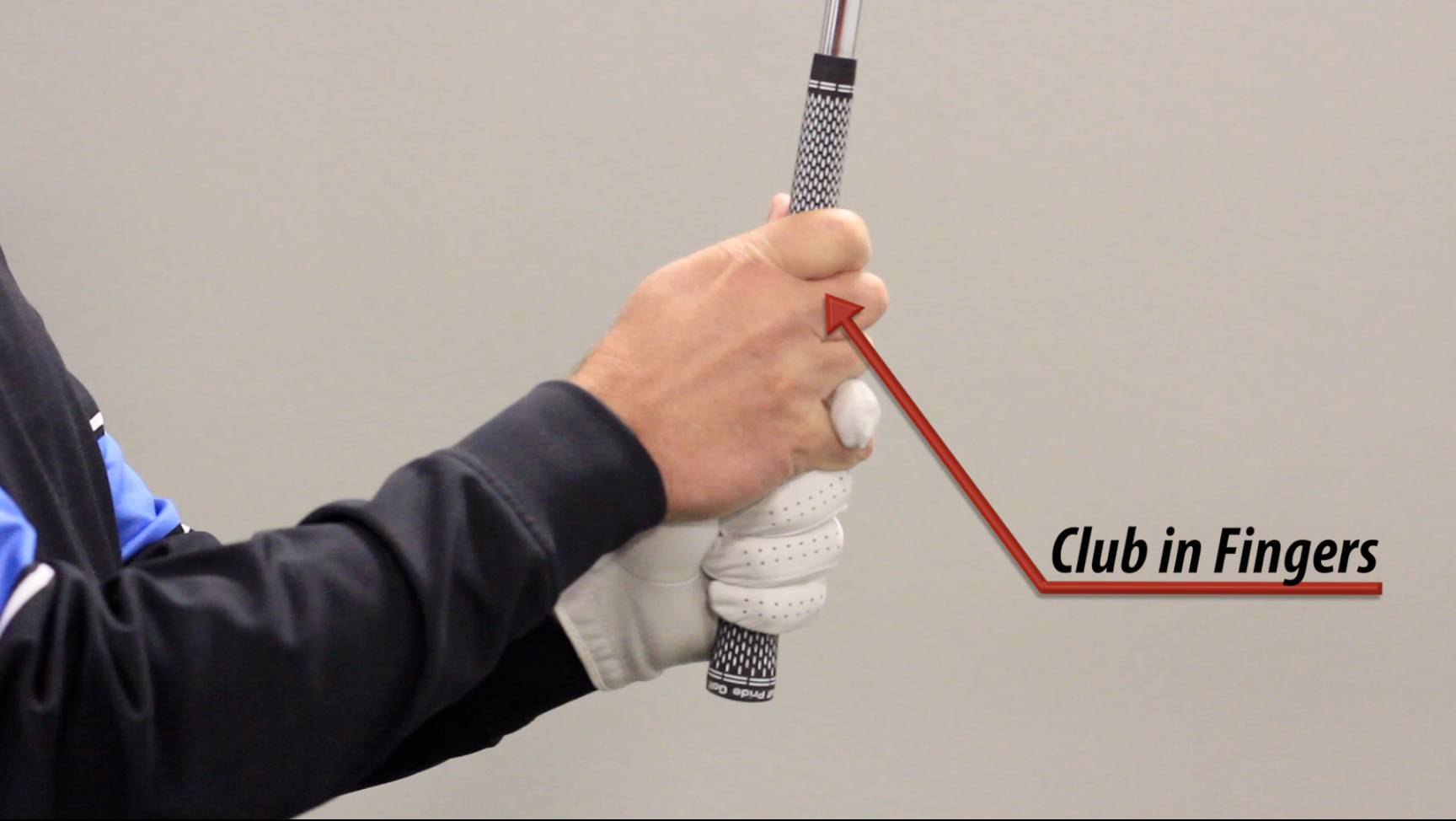
3. Master the Senior Golfer’s Golf Posture
After we have a good grip, we need to get into the right golf posture.
- First place the ball in the middle of your stance.
- Hold your club out in front of you with a good grip and bend your knees just a little bit.
- Bend at the waist until the club is on the ground. This is the most consistent way to get into the correct golf posture.
4. Flare Your Toes for More Stability
If your toes are pointed straight out ahead of you, rotate them out away from each other so the distance between your toes increases slightly. Your toes should be facing outward a little.
This tip helps the lower body rotate away from the target in your backswing and towards the target in the downswing.
5. Stay Loose and Relaxed in the Upper Body
I don’t know if you’ve noticed, but I certainly have:
As we get older, we tend to get more stiff and rigid.
When you’re addressing the golf ball, you want to be especially aware of what’s going on in your neck, shoulders, and arms. If you feel tension in these areas, it means those muscles are tight and will restrict movement. You’ll end up with a shorter swing and a weaker shot.
Now, I know it’s not always easy to relax on command. So here’s a drill for senior golfers to help you loosen those muscles and get your old range of motion back.
Tension-Relieving Swing Drill
(Side note: I like to run this drill with a regular 8-iron.)
- Take your setup without a golf ball.
- Take your backswing, bringing the clubhead far enough to lightly touch your trail shoulder.
- Swing through, brushing the mat or ground with the clubhead.
- Finish with the clubhead lightly touching your lead shoulder.
- Repeat this swing in a continuous motion, touching the trail shoulder on the backswing and the lead shoulder on the finish.
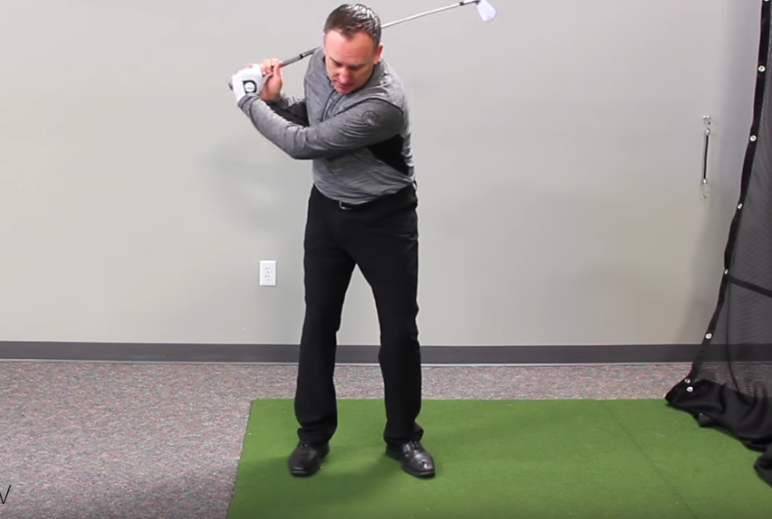
As you continue swinging back and forth, always reaching for that shoulder touch, you’ll start to feel your muscles relax into the motion. I’ve found that this drill has helped a lot of my golfers. You can also try hitting golf balls as you do this drill.
6. Allow Movement in the Hips
Odds are decent that someone, at some point, has told you to bend your trail knee and lock it down to restrict hip movement in your swing.
This is an extremely common golf tip. And I adamantly disagree with it. Especially when it comes to more senior golfers.
When you restrict hip movement, you put a limit on your range of motion. Those of us who are getting a little older don’t quite have the flexibility in our upper bodies to adjust for that restriction.
And for senior golfers dealing with a sore hip or bad knee, you risk added strain by locking the knee and restricting the hip. I can attest that even in the best of health, I feel a little pain in the lower back when I follow the no-hip-movement rule. I wind up with a swing that’s less comfortable and less effective.
My advice is to let your trail knee release on the backswing and let your hips turn. This widens your range of motion so you can get a longer, more power-packed swing. You’ll also make it a few more holes before you have to reach for the ibuprofen.
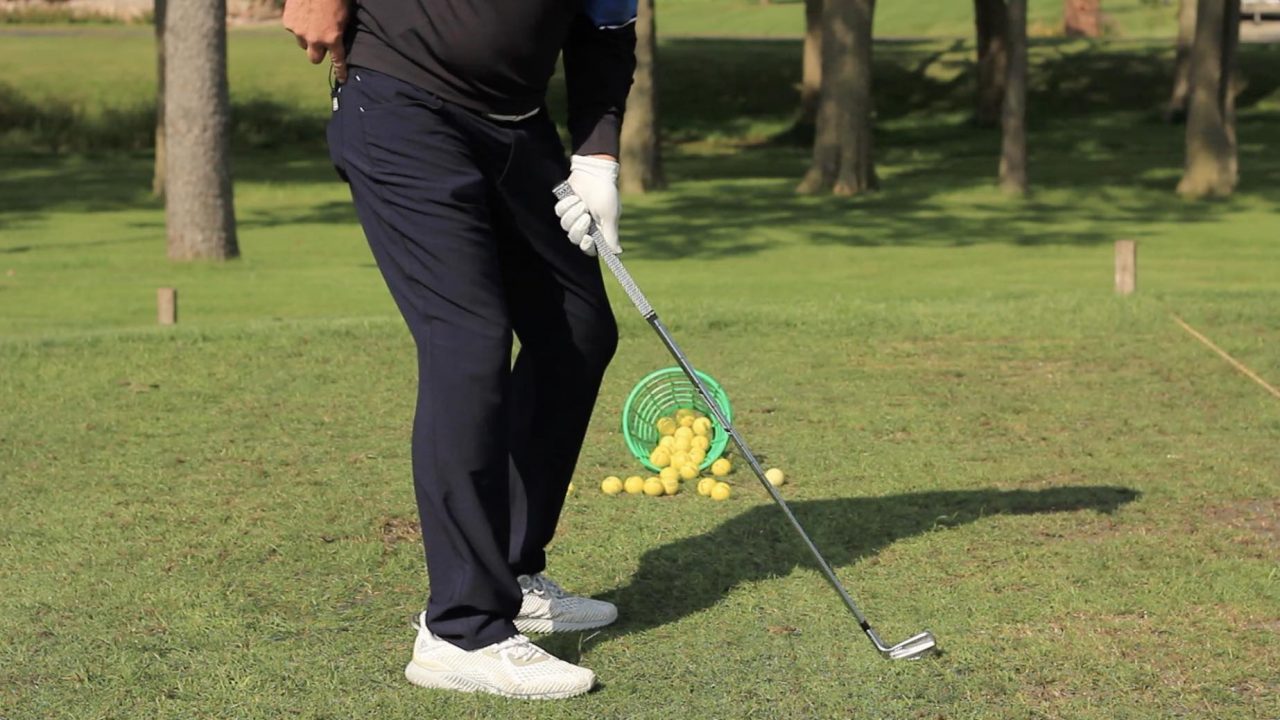
7. Create Swing Speed by Shifting Pressure
By now, you understand the main concept:
In order to keep hitting great golf shots, we have to maintain a wide range of motion. That range of motion is what helps us generate speed.
Now, there are three specific types of motion that create speed for solid golf shots.
In the previous tips, we covered the first type of motion: turning.
RELATED: HOW GOLF MOBILITY CAN INCREASE DISTANCE
The second type of motion is extension—that movement of pushing up off the ground as you swing through. You probably did this somewhat naturally once upon a time, but most of us find that extension is suddenly more challenging as we get older.
However, the third type of motion is entirely accessible to you, whether you are a beginner or senior golfer. That is the side-to-side motion in which you shift pressure from one side of your body to the other. (You may think of it as shifting “weight.”)
This energy shift helps you pick up momentum and generate speed.
How to Shift Weight in the Golf Swing
- Start with more pressure on your lead foot—about 55% or 60%.
- As you take your backswing, push that majority pressure towards your trail foot—specifically towards the heel.
- As you swing through, push pressure back into the lead foot and towards the target.
Get in the habit of shifting side-to-side, and you’ll start to see more power in your golf shots.
8. Find More Loft With Your Driver
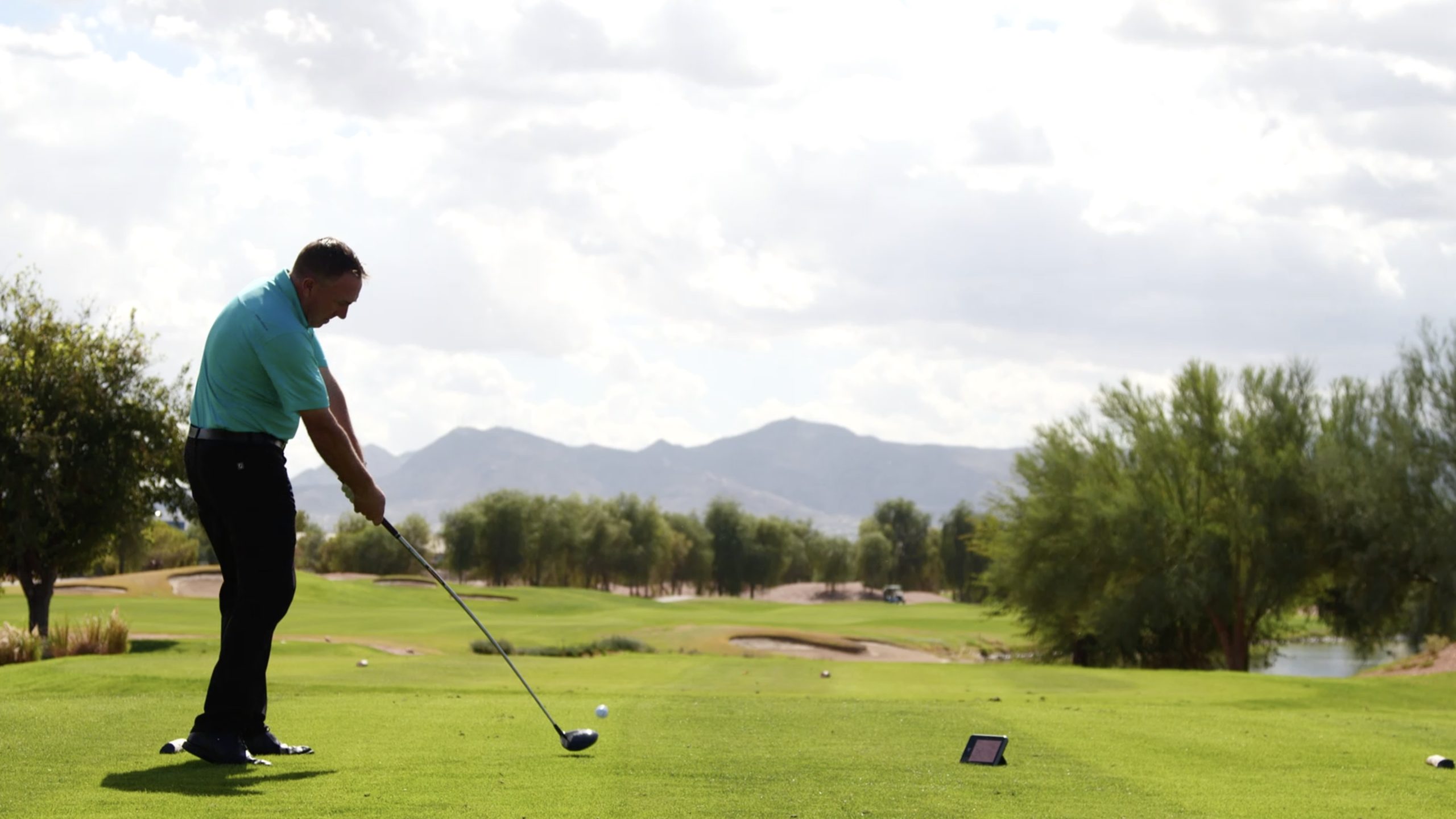
Young golfers have the ability and flexibility to create separation between the hips and shoulders. The shoulders turn way more than the hips creating a coil effect that unwinds in the downswing causing some really high club head speeds.
The older we get, the harder it is to generate that swing speed. This fact is extremely important to understand as it has to do with launch angle and how the golf ball travels into the air.
The faster the club moves at impact, the easier it is to hit the ball high in the air with lower loft. As we lose the clubhead speed, we need to account for the loss of loft in our ball flight.
For seniors, purchasing a driver with a shaft that is not as stiff and one that has higher natural loft like 12 degrees will help you hit that sweet spot and keep hitting those drives far.
If purchasing a new driver is not an option, try pushing your ball farther up in your stance allowing you to swing more up on the golf ball. This will turn your 10 degree driver into a 12 degree just like that!
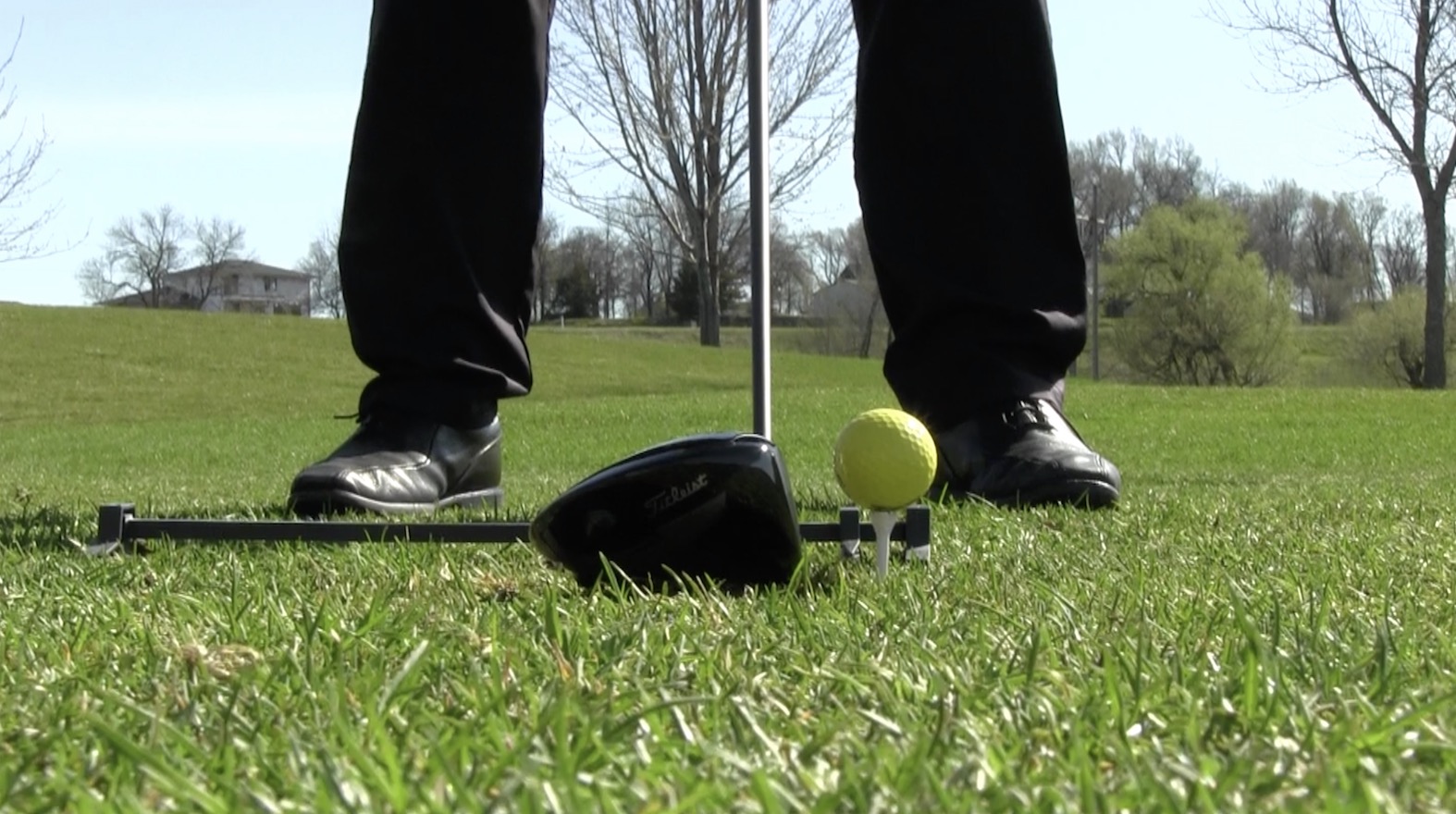
9. Maintain a Consistent Swing Radius on Chip Shots
Since we are on the topic of loft, let’s dive into a quick tip on chipping.
As we all know, the higher the loft of the shot, the softer it lands on the green. Most amateur golfers have an inefficient chipping motion that delofts the club.
Since the club is now delofted, players try to add loft by using their body. For seniors, this move can become challenging.
Here is a great tip to keep the natural loft on your chip shots to improve consistency:
The inefficient move I referenced before involves an extension of the arms away from our body in the backswing. Extending the arms away from the body lengthens our swing radius.
If we do not move our body forward in the chipping motion, we will hit way behind the ball. This movement of the body forward delofts the club.
Work on keeping your swing radius consistent throughout the entire chip shot, allowing the natural loft of the club to get the ball up in the air higher and softer.
A good drill to practice for this is right-hand-only chip shots. When you hit a chip shot with your right hand only the radius does not change. Try extending your arm in the backswing to feel the wrong move. Then try shortening your arm in the backswing to feel the opposite.
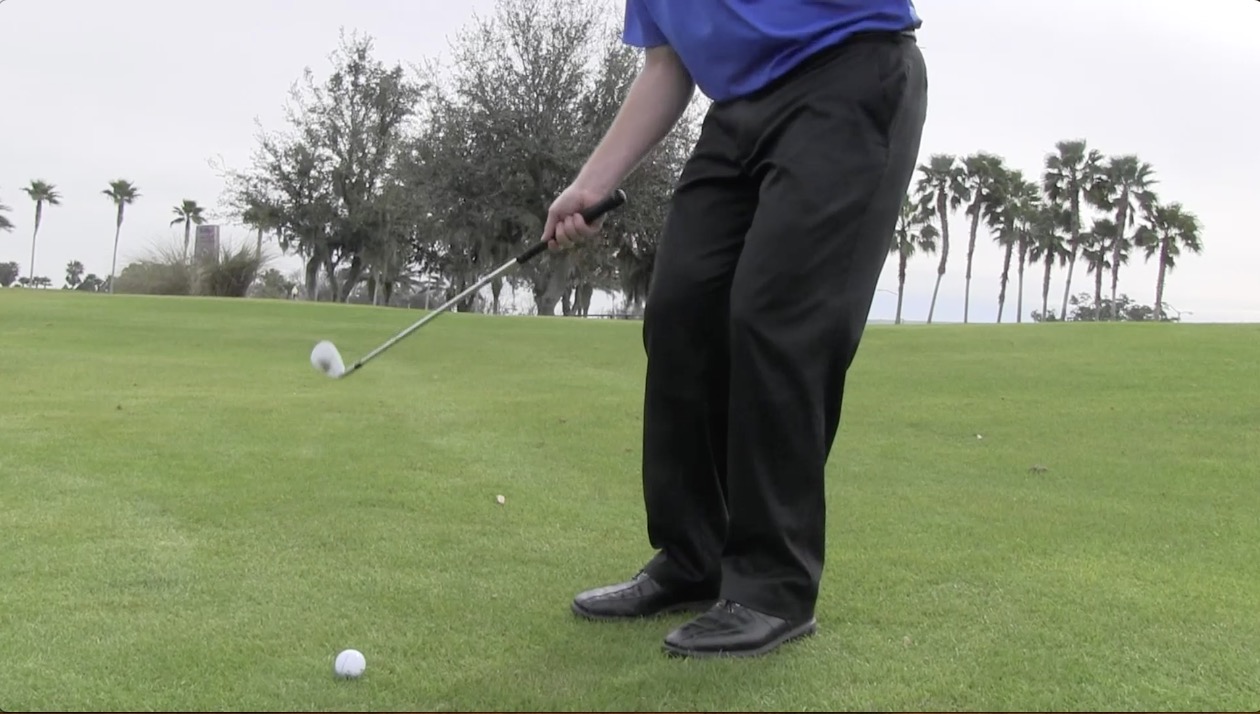
After hitting a few chips with our right hand only, we can try to replicate the feel with both hands.
Really pay attention to the distance between your hands and your torso. This distance should not change throughout the entire chipping motion. If you want to hit it even higher, try shortening the radius in the follow-through!
10. Play the Right Tees
We have all heard the saying “play it forward” before. This has become a hot topic over the past few years. We as golfers have a lot of pride in our game and for seniors, this pride can get in the way of our enjoyment of the game.
I know that it is cliche for me to jump on the “play it forward” bandwagon, but I truly do believe it is in the best interest of everyone to play the next tee up.
Someone recently told me of a new way to look at moving up to the next closest tee. He said to me that when he was younger playing from the back tees, he hit his 8-iron 160 yards. His 8-iron now goes 100 yards.
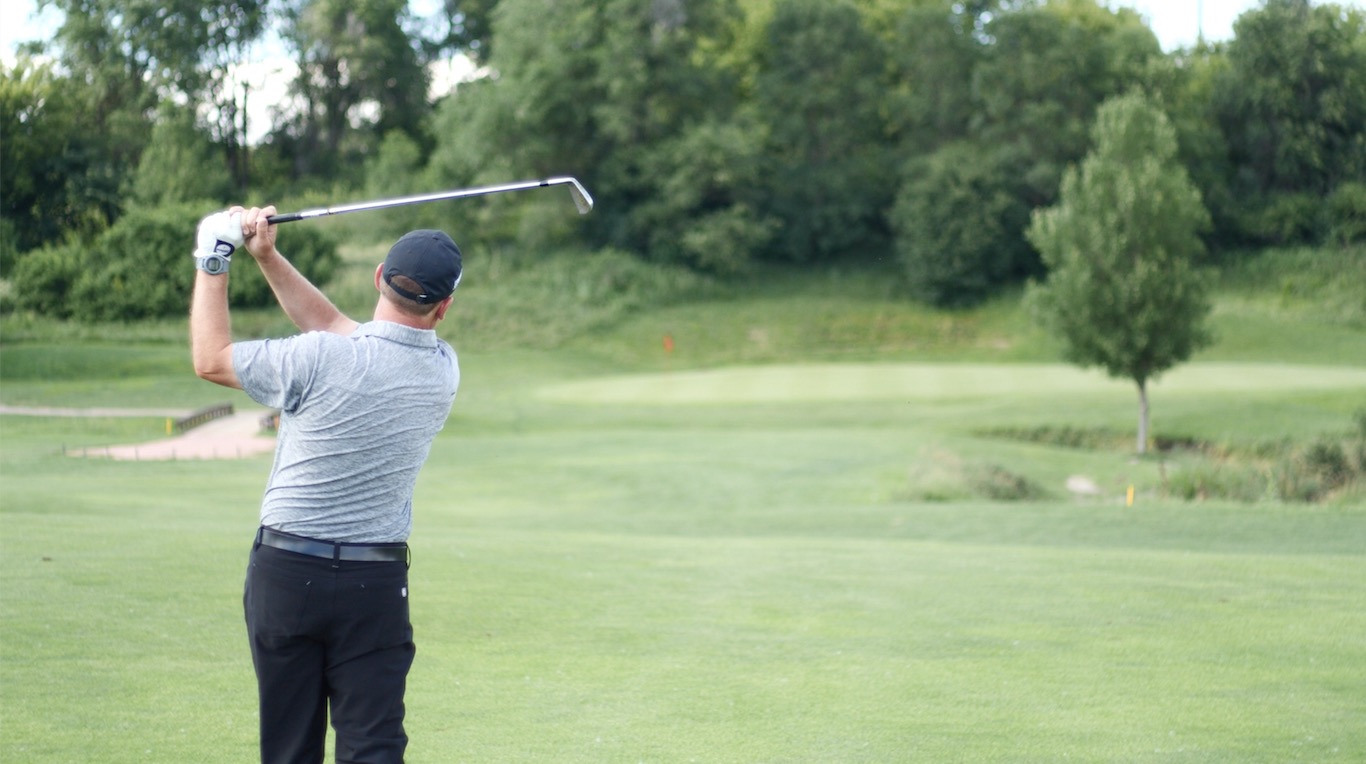
His point was that he wanted to hit the same golf club onto the green as he did when he was younger. Playing the tee in which he hit an 8-iron into the green was no different than when he played the back tees as a young adult.
It still takes the same amount of talent to hit that golf shot. So instead of struggling to get to par 4s in two, he is now hitting the same golf club into the greens and enjoying his golf game a lot more!
Next time you go out to play a round of golf, try to find the tee box that allows you to hit the same golf club into the par 4s as you would have in your younger years. I promise, you will start loving the game of golf again!
Best Golf Stretches for Seniors
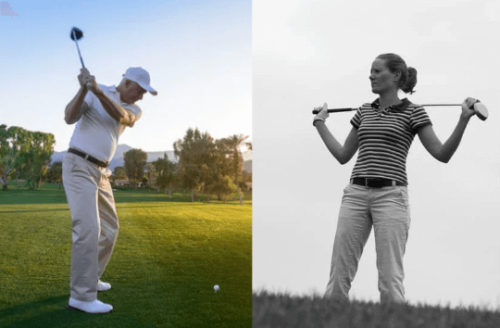
A good stretch and warm-up routine are essential for finding more range of motion and, more importantly, avoiding injury on the golf course. This is especially true as we get older.
Here are a few quick tricks that will help you go into your next round warmed up for optimal performance:
The 90/90 Drill
I don’t know your exact situation, so I strongly encourage you to consult a physical therapist to address any specific concerns you have. But generally speaking, this drill is great for both stretching your hips and helping you gauge your current level of flexibility.
It works like this:
- Sit on the ground with your legs out in front of you, feet wide, and knees bent to 90 degrees.
- Reach your arms straight out in front of you.
- Rotate both legs from the hip sockets in the same direction so your knees move toward the ground.
- Switch back toward the other direction. You should be creating a windshield wiper motion with your knees.
Don’t worry if you immediately lose your balance as soon as you reach your arms out. That just tells you that you need to work on your hip flexibility. Stick with this drill, and you’ll see improvement.
The Pivot Warm-Up
Once again, we want to get the hips loose. A good golf swing starts with a good pivot, and a good pivot starts with mobility in the lower body.
Here are a couple drills to get that lower body warmed up and help you tap into that power-generating weight shift:
Step Forward Drill
- Take your regular setup with your driver.
- Step your lead foot back so it’s directly beside your trail foot.
- Take your golf swing, stepping forward with your lead foot as you swing through.
Step Back Drill
- Take your regular setup with your driver.
- Step your trail foot forward so it’s directly beside your lead foot.
- Take your golf swing, stepping back with your trail foot on the backswing.
The Pre-round Routine
Finally, if you’re heading out to the course for a round of golf, get to the driving range early so you have plenty of time to practice all your shots. I recommend:
- 6 wedge shots
- 6 mid-irons
- 6 drivers
- 6 chips
- 6 putts
For each one, pay close attention to your ball position and stance. When you take even just a little time to drill those fundamentals before a round, you’ll find it easier to slip into the proper technique when it counts.
Best Golf Techniques for Seniors
Here are some key techniques that always help my senior students find more stability and distance in their swing:
- Stance: In your setup, flare your toes a bit. That will give you more stability throughout your swing.
- Aim: Rather than standing with your toes square to the target line, shift your trail foot back from the ball so your stance aims about 10 degrees to the right of the target line (if you’re right-handed). This is going to give you more room to rotate on the backswing, increasing your range of motion if you’ve lost some flexibility.
- Lead hip: In the setup, bump your lead hip forward, toward the target. This sets you up to shift toward the trail heel in your backswing, creating a more effective weight transition for better swing speed.
- Finish: It’s important that you maintain balance through the finish, even as you rotate your body toward the target. That can be tricky as we get older, but you can help yourself out by flaring your lead toe out a little more than your trail toe in the setup.
Best Golf Instruction for Seniors
I recommend seeking out golf instruction for seniors specifically. Any advice geared toward a more general audience is going to be packed with tips that assume you’re still twisting like a twenty-five-year-old.
Now, I may be a bit biased here, but my top recommendation for senior golf instruction is the VLS Golf Swing.
I created this method based on three decades of coaching golfers of all levels. It capitalizes on your natural strengths without forcing you to attempt maneuvers that just aren’t possible for you anymore.
A lof of my senior students aren’t just playing better with this method; they’re playing the best golf of their lives.
Learn more about the Vertical Line Swing System here.
FAQs on Golf Tips for Seniors
Why Do Older Golfers Have Higher Handicaps?
As we get older, we lose strength, flexibility, and balance. These losses can take a huge toll on our golf game if we don’t know how to adjust our technique to overcome them. And most amateur golfers don’t.
Why Isn’t My Golf Game Improving?
If you’re a senior golfer who plays and practices a lot but sees no improvement, the problem probably isn’t you.
Most traditional golf instruction is based on the techniques that work for professional golfers and instructors. If you don’t have the strength and flexibility of an elite athlete, those strategies are more likely to destroy your speed and contact. Seek out instruction geared toward seniors, like the VLS System.
How Can I Get More Clubhead Speed as a Senior Golfer?
Rather than relying on painful body rotation or raw power, focus on shifting the weight in your feet throughout your swing. This creates momentum that will really help accelerate your swing.
Related Articles for Senior Golfers
Your body may feel stiffer and more restricted than it once did, but that hardly means your best golf days are behind you. Check out these articles for more tips geared toward golfers like you:
- Top 5 Todd Kolb Driver Tips for Senior Golfers
- 3 Senior Driver Tips That Get Immediate Results
- Increase Clubhead Speed for Senior Golfers
In the meantime, let us know your thoughts!
Did these tips help? Are there any other difficulties you run into as a senior golfer? Anything here you disagree with?
Drop us a line in the comments and let us know!
And be sure to follow us Facebook, Twitter and Instagram for more product reviews, golf tips, and information on new brands. For helpful video tips, subscribe to our YouTube channel!
If you’re ready to take your game to the next level with customized coaching or one-on-one instruction, visit us at VLSCoaching.com. Or drop us an email at Info@VLSGolf.com and put COACHING in the subject line. We’ll get back to you right away.
About the Instructor
I’m PGA Teaching Professional Todd Kolb—a four-time Golf Digest Best-in-State Instructor, Amazon Best-selling Author, and Minnesota PGA Teacher of the Year. I’ve worked with students of all ages and skill levels in my 30 years of coaching, from first-timers to an LPGA major champion. I’m also the Director of Instruction for VLS Golf and USGolfTV.
My work with VLS Golf and USGolfTV revolves around helping the everyday golfer cut through overcomplicated traditional instruction to find solutions that actually work for them.


Please clarify Senior Golf Tip #1, Drill: as stated the drill says to touch the trail shoulder with the “club head” on the backswing and touch the left shoulder with the “club head” on the follow-through. After watching the diagram, I think the term “club head” was meant to say “club shaft”.
Thanks for the tips for Senior Golfers. I seem to be more mobile and have regained some of my lost distance.
Taylor, good pick up. Yes, it is the clubshaft which touches the shoulder on both sides. Will make the update. Thanks!
Thanks for reading and taking the time to comment Charlie! Which tip did you find most useful?
Your insight and instructions have helped me tremendously. I think your probably on of the best teachers I’ve ever seen. I work very hard to keep my flexibility as a major accident has left me with half a dozen disc problems. What can you share for conditioning as my handicap doubles in the last half of my game. I try to golf once a week, and go to the range once a week.
Thanks for such good videos.
Tom 68 years old
Great tips for us MATURE golfers I m 76 and not very big 5ft.4in. 132 ibs so I was never able to hit 275yrds drives and had lost considerable distance over the past 5 yrs. I have found that keeping tension out of my swing by gripping the club as hard as I can and just before taking the club back loosen the grip and that seems to take all the tension out of the swing and I also keep about 75% of my weight on both heels for the entire swing which helps me get a better hip turn and offsets gravity pulling you off balance . Please let me know what you think
William, you are spot on! Yes, I have used the drill of creating tension then relaxing, then creating tension, then relaxing to help our students improve swing speed and contact. We have some great drills like this on our YouTube channel also…good stuff!
Tom, thanks for posting! So great to see you still golfing at 68…good for you! Check out this video for some ideas on how to help https://youtu.be/lJCrJUQ00Jk
Here is another great one on flexibility https://youtu.be/_N_IHdapTug
I have watched many golf instruction videos and I have not seen anyone ( maybe I’m not understanding correctly), emphasize on your downswing to snap your wrists at impact. I heard Gary Player say to “” light the match”. Is there a
drill to help that so you get more distance. I am a male golfer over 70 so any help in that direction would be appreciated.Ra
Randy,
Thanks for posting. Here is a great video to get you going https://youtu.be/BaSutRNjJ98